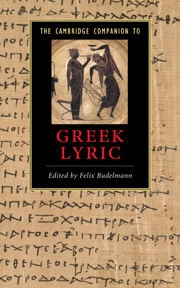Book contents
- Frontmatter
- Introducing Greek lyric
- Part I: Contexts and topics
- 1 Genre, occasion and performance
- 2 Greek lyric and the politics and sociologies of archaic and classical Greek communities
- 3 Greek lyric and gender
- 4 Greek lyric and the place of humans in the world
- 5 Greek lyric and early Greek literary history
- 6 Language and pragmatics
- 7 Metre and music
- Part II: Poets and traditions
- Part III: Reception
- Chronology of select melic, elegiac and iambic poets
- Further Reading
- Glossary
- List of works cited
- Index
1 - Genre, occasion and performance
from Part I: - Contexts and topics
Published online by Cambridge University Press: 28 May 2010
- Frontmatter
- Introducing Greek lyric
- Part I: Contexts and topics
- 1 Genre, occasion and performance
- 2 Greek lyric and the politics and sociologies of archaic and classical Greek communities
- 3 Greek lyric and gender
- 4 Greek lyric and the place of humans in the world
- 5 Greek lyric and early Greek literary history
- 6 Language and pragmatics
- 7 Metre and music
- Part II: Poets and traditions
- Part III: Reception
- Chronology of select melic, elegiac and iambic poets
- Further Reading
- Glossary
- List of works cited
- Index
Summary
The nature of genre
The urge to categorise creative art has an excellent pedigree. In the case of lyric, the concept and some of the labels are there already in the Homeric poems, which identify both specific contexts for sung performances and also terminology for certain kinds of song. At Il. 1.473 the Greek emissaries to Chryses sing a paean to Apollo at the sacrifice and feast which follows the reversal of the offence against the god. A paean is again sung by the Greeks after the killing of Hector (Il. 22.391). The wedding depicted on Achilles' shield includes a song explicitly termed a hymenaios (Il. 18.492), the term later used for wedding songs. At Hector's funeral, the verb thrêneô and the noun thrênos (the standard term later for sung lament) are used of the song of mourning sung for him. The depiction of the harvesting on Achilles' shield (Il. 18.570) includes the singing of a Linos-song. The list is not exhaustive even for its own day, for it omits the dithyramb in honour of Dionysus, just as the Homeric poems in general avoid Dionysus, even though his worship goes back to the Bronze Age.
- Type
- Chapter
- Information
- The Cambridge Companion to Greek Lyric , pp. 21 - 38Publisher: Cambridge University PressPrint publication year: 2009
- 11
- Cited by

